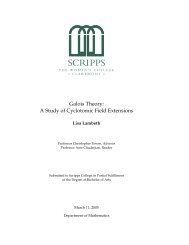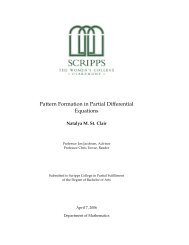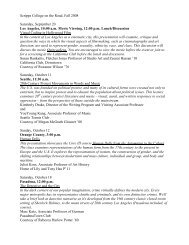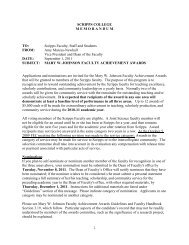Sophie Germain: mathématicienne extraordinaire - Scripps College
Sophie Germain: mathématicienne extraordinaire - Scripps College
Sophie Germain: mathématicienne extraordinaire - Scripps College
Create successful ePaper yourself
Turn your PDF publications into a flip-book with our unique Google optimized e-Paper software.
Chapter 5<br />
<strong>Sophie</strong> <strong>Germain</strong><br />
5.1 Case 1, Case 2<br />
Fermat’s Last Theorem states that the equation x n + y n = z n has no nontrivial<br />
integer solutions when n > 2. Recall we may assume that x, y, and<br />
z are relatively prime. Earlier, for n = 5, we broke this theorem down into<br />
two cases. We can do this in general in the following manner:<br />
Fermat’s Last Theorem 4 (By Cases).<br />
Case 1. We claim that the equation x n + y n = z n has no non-trivial integer solutions<br />
when n > 2 and n ∤ xyz.<br />
In other words, if there did exist any positive integer solution (a, b, c) of<br />
x n + y n = z n , then exactly one of a, b, or c is a multiple of n, since a, b, and<br />
c are relatively prime.<br />
Case 2. We claim that the equation x n + y n = z n has no non-trivial integer solutions<br />
when n > 2 and n|xyz.
















